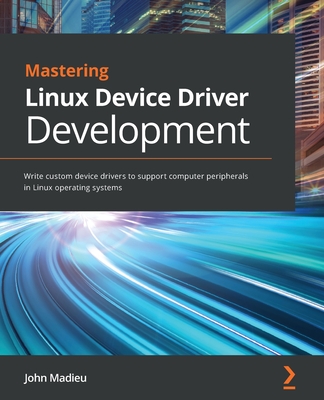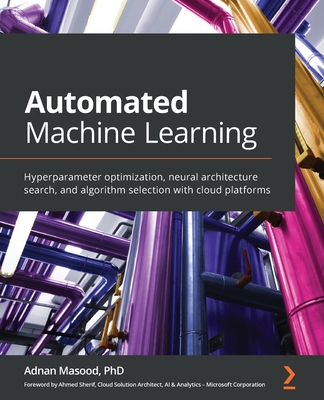Mastering Embedded Linux Programming, 3/e (Paperback)
暫譯: 精通嵌入式 Linux 程式設計 (第三版)
9781789530384
- 出版商: Packt Publishing
- 出版日期: 2021-05-14
- 售價: $2,200
- 貴賓價: 9.5 折 $2,090
- 語言: 英文
- 頁數: 758
- 裝訂: Quality Paper - also called trade paper
- ISBN: 1789530385
- ISBN-13: 9781789530384
-
相關分類:
嵌入式系統、Linux
-
相關翻譯:
精通嵌入式 Linux 程式設計, 3/e (上) (繁中版)
精通嵌入式 Linux 程式設計, 3/e (下) (繁中版)
精通嵌入式 Linux 編程, 3/e (簡中版)
立即出貨 (庫存=1)
買這商品的人也買了...
-
 C 語言程式設計 + C 語言程式技巧問答實戰 (Kernighan: The C Programming Language, 2/e) (雙書合購)
C 語言程式設計 + C 語言程式技巧問答實戰 (Kernighan: The C Programming Language, 2/e) (雙書合購)$980$980 -
 Clean Code: A Handbook of Agile Software Craftsmanship (Paperback)
Clean Code: A Handbook of Agile Software Craftsmanship (Paperback)$2,200$2,090 -
 PL2303HXD USB 轉 TTL 傳輸線
PL2303HXD USB 轉 TTL 傳輸線$200$190 -
 $301精通 Nginx, 2/e ( Mastering NGINX, 2/e)
$301精通 Nginx, 2/e ( Mastering NGINX, 2/e) -
 Embedded Linux Development using Yocto Project Cookbook, 2/e (Paperback)
Embedded Linux Development using Yocto Project Cookbook, 2/e (Paperback)$1,980$1,881 -
 C++ Concurrency in Action, 2/e (Paperback)
C++ Concurrency in Action, 2/e (Paperback)$2,394$2,268 -
 精通嵌入式 Linux 程式設計 (暢銷回饋版)
精通嵌入式 Linux 程式設計 (暢銷回饋版)$620$484 -
 The Pragmatic Programmer 20週年紀念版 (The Pragmatic Programmer, 20th Anniversary Edition)
The Pragmatic Programmer 20週年紀念版 (The Pragmatic Programmer, 20th Anniversary Edition)$680$537 -
 $1,080Algorithmic Thinking: A Problem-Based Introduction
$1,080Algorithmic Thinking: A Problem-Based Introduction -
 Mastering Linux Device Driver Development: Write custom device drivers to support computer peripherals in Linux operating systems (Paperback)
Mastering Linux Device Driver Development: Write custom device drivers to support computer peripherals in Linux operating systems (Paperback)$1,980$1,881 -
 $735奔跑吧 Linux 內核入門篇, 2/e
$735奔跑吧 Linux 內核入門篇, 2/e -
 $1,620How Linux Works : What Every Superuser Should Know, 3/e (Paperback)
$1,620How Linux Works : What Every Superuser Should Know, 3/e (Paperback) -
 練核心從裡強到外:全面了解 Linux 基礎架構
練核心從裡強到外:全面了解 Linux 基礎架構$1,000$790 -
 $607Linux 嵌入式系統開發從小白到大牛
$607Linux 嵌入式系統開發從小白到大牛 -
 大師養成起手式:從核心真正了解 Linux 運作原理
大師養成起手式:從核心真正了解 Linux 運作原理$880$695 -
 System Programming Vol I (Paperback)
System Programming Vol I (Paperback)$1,900$1,862 -
 System Programming Vol II (Paperback)
System Programming Vol II (Paperback)$1,900$1,862 -
 Linux Device Driver Development : Everything you need to start with device driver development for Linux kernel and embedded Linux, 2/e (Paperback)
Linux Device Driver Development : Everything you need to start with device driver development for Linux kernel and embedded Linux, 2/e (Paperback)$1,980$1,881 -
 Visual C# 2022 基礎必修課
Visual C# 2022 基礎必修課$540$427 -
 $1,440Linux Kernel Debugging: Leverage proven tools and advanced techniques to effectively debug Linux kernels and kernel modules (Paperback)
$1,440Linux Kernel Debugging: Leverage proven tools and advanced techniques to effectively debug Linux kernels and kernel modules (Paperback) -
 $2,363C++ Software Design: Design Principles and Patterns for High-Quality Software (Paperback)
$2,363C++ Software Design: Design Principles and Patterns for High-Quality Software (Paperback) -
 精通嵌入式 Linux 程式設計, 3/e (上)
精通嵌入式 Linux 程式設計, 3/e (上)$750$585 -
 精通嵌入式 Linux 程式設計, 3/e (下)
精通嵌入式 Linux 程式設計, 3/e (下)$450$351 -
 C++ Programming for Linux Systems: Create robust enterprise software for Linux and Unix-based operating systems (Paperback)
C++ Programming for Linux Systems: Create robust enterprise software for Linux and Unix-based operating systems (Paperback)$1,880$1,786 -
 樹莓派 Raspberry Pi 5 Model B / 8GB 原廠紅白外殼全配(含 Pi 5/8GB 主板 + 64G microSD 卡 + 原廠電源 + 原廠紅白外殼附散熱風扇 + 原廠 micro HDMI 線)
樹莓派 Raspberry Pi 5 Model B / 8GB 原廠紅白外殼全配(含 Pi 5/8GB 主板 + 64G microSD 卡 + 原廠電源 + 原廠紅白外殼附散熱風扇 + 原廠 micro HDMI 線)$5,210$4,950
商品描述
Harness the power of Linux to create versatile and robust embedded solutions
Key Features:
- Learn how to develop and configure robust embedded Linux devices
- Explore the new features of Linux 5.4 and the Yocto Project 3.1 (Dunfell)
- Discover different ways to debug and profile your code in both user space and the Linux kernel
Book Description:
Embedded Linux runs many of the devices we use every day. From smart TVs and Wi-Fi routers to test equipment and industrial controllers, all of them have Linux at their heart. The Linux OS is one of the foundational technologies comprising the core of the Internet of Things (IoT).
This book starts by breaking down the fundamental elements that underpin all embedded Linux projects: the toolchain, the bootloader, the kernel, and the root filesystem. After that, you will learn how to create each of these elements from scratch and automate the process using Buildroot and the Yocto Project. As you progress, the book explains how to implement an effective storage strategy for flash memory chips and install updates to a device remotely once it's deployed. You'll also learn about the key aspects of writing code for embedded Linux, such as how to access hardware from apps, the implications of writing multi-threaded code, and techniques to manage memory in an efficient way. The final chapters demonstrate how to debug your code, whether it resides in apps or in the Linux kernel itself. You'll also cover the different tracers and profilers that are available for Linux so that you can quickly pinpoint any performance bottlenecks in your system.
By the end of this Linux book, you'll be able to create efficient and secure embedded devices using Linux.
What You Will Learn:
- Use Buildroot and the Yocto Project to create embedded Linux systems
- Troubleshoot BitBake build failures and streamline your Yocto development workflow
- Update IoT devices securely in the field using Mender or balena
- Prototype peripheral additions by reading schematics, modifying device trees, soldering breakout boards, and probing pins with a logic analyzer
- Interact with hardware without having to write kernel device drivers
- Divide your system up into services supervised by BusyBox runit
- Debug devices remotely using GDB and measure the performance of systems using tools such as perf, ftrace, eBPF, and Callgrind
Who this book is for:
If you're a systems software engineer or system administrator who wants to learn Linux implementation on embedded devices, then this book is for you. Embedded systems engineers accustomed to programming for low-power microcontrollers can use this book to help make the leap to high-speed systems on chips that can run Linux. Anyone responsible for developing new hardware that needs to run Linux will also find this book useful. Basic working knowledge of the POSIX standard, C programming, and shell scripting is assumed.
商品描述(中文翻譯)
利用 Linux 的力量創建多功能且穩健的嵌入式解決方案
主要特點:
- 學習如何開發和配置穩健的嵌入式 Linux 設備
- 探索 Linux 5.4 和 Yocto Project 3.1 (Dunfell) 的新功能
- 發現不同的方法來調試和分析您在用戶空間和 Linux 核心中的代碼
書籍描述:
嵌入式 Linux 運行著我們每天使用的許多設備。從智能電視和 Wi-Fi 路由器到測試設備和工業控制器,所有這些設備的核心都是 Linux。Linux 作業系統是構成物聯網 (IoT) 核心的基礎技術之一。
本書首先分解所有嵌入式 Linux 項目的基本元素:工具鏈、引導加載程序、內核和根文件系統。之後,您將學習如何從零開始創建這些元素,並使用 Buildroot 和 Yocto Project 自動化該過程。隨著進展,本書解釋了如何為閃存記憶體芯片實施有效的存儲策略,以及如何在設備部署後遠程安裝更新。您還將學習編寫嵌入式 Linux 代碼的關鍵方面,例如如何從應用程序訪問硬體、編寫多線程代碼的影響,以及有效管理內存的技術。最後幾章展示了如何調試您的代碼,無論它位於應用程序中還是在 Linux 內核中。您還將涵蓋可用於 Linux 的不同跟蹤器和分析器,以便快速找出系統中的性能瓶頸。
到本書結束時,您將能夠使用 Linux 創建高效且安全的嵌入式設備。
您將學到的內容:
- 使用 Buildroot 和 Yocto Project 創建嵌入式 Linux 系統
- 排除 BitBake 構建失敗的故障並簡化您的 Yocto 開發工作流程
- 使用 Mender 或 balena 在現場安全地更新 IoT 設備
- 通過閱讀原理圖、修改設備樹、焊接擴展板和使用邏輯分析儀探測引腳來原型化外圍設備的添加
- 與硬體互動而無需編寫內核設備驅動程序
- 將系統劃分為由 BusyBox runit 監控的服務
- 使用 GDB 遠程調試設備,並使用 perf、ftrace、eBPF 和 Callgrind 等工具測量系統性能
本書適合誰:
如果您是希望學習嵌入式設備上 Linux 實現的系統軟體工程師或系統管理員,那麼本書適合您。習慣於為低功耗微控制器編程的嵌入式系統工程師可以使用本書幫助他們轉向可以運行 Linux 的高速系統芯片。任何負責開發需要運行 Linux 的新硬體的人也會發現本書有用。假設您具備 POSIX 標準、C 程式設計和 shell 腳本的基本工作知識。














